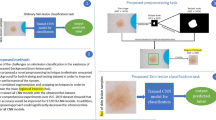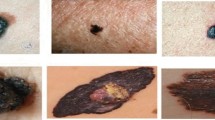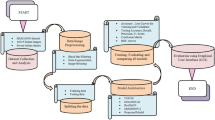Abstract
In recent decades, many people have died because of cancer. Like many diseases, early detection of the disease can greatly help the healing process of the sick people. One of the most common types of cancer is the skin cancer. Skin lesions can lead to a kind of malignant cancer. Hence, it is important to diagnose the type of the skin lesion. Mostly, the skin lesion diagnosis needs to be done by an expert dermatologist. But a dermatologist’s examination can be time consuming and inaccurate. Therefore, using modern computer aided diagnosis methods can help to increase the speed and accuracy of the diagnosis of this disease. This paper proposes a new approach for skin lesion recognition using a new Convolutional Neural Network (CNN) with 69 layers. The proposed method has been tested on three benchmark datasets of skin lesions including PH2, ISIC 2016, and ISIC 2017. The experimental results illustrate that the proposed method performs better compared to the state-of-the-art in the field. Our method reached to 97.2%, 96.3%, and 99.4% of accuracy on PH2, ISIC2016, and ISIC2017 datasets, respectively.














Similar content being viewed by others
Data availability
It is necessary to mention that, Data sharing not applicable to this article as no datasets were generated or analyzed during the current study.
References
Abbas Q, Garcia IF, Rashid M (2010) Automatic skin tumour border detection for digital dermoscopy using a new digital image analysis scheme. Br J Biomed Sci 67(4):177–183
Albelwi S, Mahmood A (2017) A framework for designing the architectures of deep convolutional neural networks. Entropy 19(6):242
Al-Masni MA, Al-Antari MA, Choi MT, Han SM, Kim TS (2018) Skin lesion segmentation in dermoscopy images via deep full resolution convolutional networks. Comput Methods Programs Biomed 162:221–231
Al-Masni MA, Kim DH, Kim TS (2020) Multiple skin lesions diagnostics via integrated deep convolutional networks for segmentation and classification. Comput Methods Programs Biomed 190:105351
Balch CM, Gershenwald JE, Soong SJ, Thompson JF, Atkins MB, Byrd DR ... Sondak VK (2009) Final version of 2009 AJCC melanoma staging and classification. J Clin Oncol 27(36):6199
Benyahia S, Meftah B, Lézoray O (2022) Multi-features extraction based on deep learning for skin lesion classification. Tissue Cell 74:101701
Bi L, Kim J, Ahn E, Feng D, Fulham M (2016) Automatic melanoma detection via multi-scale lesion-biased representation and joint reverse classification. In: 2016 IEEE 13th international symposium on biomedical imaging (ISBI). IEEE, pp 1055–1058
Binder M, Schwarz M, Winkler A, Steiner A, Kaider A, Wolff K, Pehamberger H (1995) Epiluminescence microscopy: a useful tool for the diagnosis of pigmented skin lesions for formally trained dermatologists. Arch Dermatol 131(3):286–291
Celebi ME, Zornberg A (2014) Automated quantification of clinically significant colors in dermoscopy images and its application to skin lesion classification. IEEE Syst J 8(3):980–984
Ching T, Himmelstein DS, Beaulieu-Jones BK, Kalinin AA, Do BT, Way GP … Greene CS (2018) Opportunities and obstacles for deep learning in biology and medicine. J R Soc Interface 15(141):20170387
Codella NC, Gutman D, Celebi ME, Helba B, Marchetti MA, Dusza SW ... Halpern A (2018) Skin lesion analysis toward melanoma detection: a challenge at the 2017 international symposium on biomedical imaging (isbi), hosted by the international skin imaging collaboration (isic). In: 2018 IEEE 15th international symposium on biomedical imaging (ISBI 2018). IEEE, pp 168-172
Esteva A, Kuprel B, Novoa RA, Ko J, Swetter SM, Blau HM, Thrun S (2017) Dermatologist-level classification of skin cancer with deep neural networks. Nature 542(7639):115–118
Gomez DD, Butakoff C, Ersboll BK, Stoecker W (2007) Independent histogram pursuit for segmentation of skin lesions. IEEE Trans Biomed Eng 55(1):157–161
Hosny KM, Kassem MA, Foaud MM (2019) Classification of skin lesions using transfer learning and augmentation with Alex-net. PloS one 14(5):e0217293
Hosny KM, Kassem MA, Foaud MM (2020) Skin melanoma classification using ROI and data augmentation with deep convolutional neural networks. Multimed Tools Appl 79(33):24029–24055
Jafari MH, Nasr-Esfahani E, Karimi N, Soroushmehr SM, Samavi S, Najarian K (2017) Extraction of skin lesions from non-dermoscopic images for surgical excision of melanoma. Int J Comput Assist Radiol Surg 12(6):1021–1030
Jerant AF, Johnson JT, Sheridan CD, Caffrey TJ (2000) Early detection and treatment of skin cancer. Am Family Phys 62(2):357–368
Khan MA, Javed MY, Sharif M, Saba T, Rehman A (2019) Multi-model deep neural network based features extraction and optimal selection approach for skin lesion classification. In: 2019 international conference on computer and information sciences (ICCIS). IEEE, pp 1–7
Khouloud S, Ahlem M, Fadel T, Amel S (2022) W-net and inception residual network for skin lesion segmentation and classification. Appl Intell 52(4):3976–3994
Korotkov K, Garcia R (2012) Computerized analysis of pigmented skin lesions: a review. Artif Intell Med 56(2):69–90
Li Z, Wang SH, Fan RR, Cao G, Zhang YD, Guo T (2019) Teeth category classification via seven-layer deep convolutional neural network with max pooling and global average pooling. Int J Imaging Syst Technol 29(4):577–583
Liu Z, Zerubia J (2015) Skin image illumination modeling and chromophore identification for melanoma diagnosis. Phys Med Biol 60(9):3415
Mahbod A, Schaefer G, Ellinger I, Ecker R, Pitiot A, Wang C (2019) Fusing fine-tuned deep features for skin lesion classification. Comput Med Imaging Graph 71:19–29
Marques JS, Barata C, Mendonça T (2012) On the role of texture and color in the classification of dermoscopy images. In: 2012 Annual international conference of the IEEE engineering in medicine and biology society. IEEE, pp 4402–4405
Nasir M, Attique Khan M, Sharif M, Lali IU, Saba T, Iqbal T (2018) An improved strategy for skin lesion detection and classification using uniform segmentation and feature selection based approach. Microsc Res Tech 81(6):528–543
Nasiri S, Jung M, Helsper J, Fathi M (2018) Deep-CLASS at ISIC machine learning challenge 2018. arXiv preprint arXiv:1807.08993
Pham TC, Luong CM, Visani M, Hoang VD (2018) Deep CNN and data augmentation for skin lesion classification. In: Asian conference on intelligent information and database systems. Springer, Cham, pp 573–582
Pratiwi RA, Nurmaini S, Rini DP (2019) Skin lesion classification based on convolutional neural networks. Comput Eng Appl J 8(3):203–216
Rebouças Filho PP, Peixoto SA, da Nóbrega RVM, Hemanth DJ, Medeiros AG, Sangaiah AK, de Albuquerque VHC (2018) Automatic histologically-closer classification of skin lesions. Comput Med Imaging Graph 68:40–54
Rizzi M, Guaragnella C (2020) Skin lesion segmentation using image bit-plane multilayer approach. Appl Sci 10(9):3045
Rogers HW, Weinstock MA, Feldman SR (2012) Coldiron BM (2015) Incidence estimate of nonmelanoma skin cancer (keratinocyte carcinomas) in the US population. JAMA Dermatol 151(10):1081–1086
Saba T, Khan MA, Rehman A, Marie-Sainte SL (2019) Region extraction and classification of skin cancer: a heterogeneous framework of deep CNN features fusion and reduction. J Med Syst 43(9):1–19
Satheesha TY, Satyanarayana D, Prasad MG, Dhruve KD (2017) Melanoma is skin deep: a 3D reconstruction technique for computerized dermoscopic skin lesion classification. IEEE J translational Eng health Med 5:1–17
Scherer D, Müller A, Behnke S (2010) Evaluation of pooling operations in convolutional architectures for object recognition. In: International conference on artificial neural networks. Springer, Berlin, pp 92–101
Singh L, Janghel RR, Sahu SP (2020) Designing a retrieval-based diagnostic aid using effective features to classify skin lesion in dermoscopic images. Procedia Comput Sci 167:2172–2180
Sultana NN, Mandal B, Puhan NB (2018) Deep residual network with regularised fisher framework for detection of melanoma. IET Comput Vision 12(8):1096–1104
Tschandl P, Sinz C, Kittler H (2019) Domain-specific classification-pretrained fully convolutional network encoders for skin lesion segmentation. Comput Biol Med 104:111–116
Waheed Z, Waheed A, Zafar M, Riaz F (2017) An efficient machine learning approach for the detection of melanoma using dermoscopic images. In: 2017 International Conference on Communication, Computing and Digital Systems (C-CODE). IEEE, pp 316–319
Youssef A, Bloisi DD, Muscio M, Pennisi A, Nardi D, Facchiano A (2018) Deep convolutional pixel-wise labeling for skin lesion image segmentation. In: 2018 IEEE International Symposium on Medical Measurements and Applications (MeMeA). IEEE, pp 1–6
Yousaf K, Mehmood Z, Saba T, Rehman A, Munshi AM, Alharbey R, Rashid M (2019) Mobile-health applications for the efficient delivery of health care facility to people with dementia (PwD) and support to their carers: a survey. Biomed Res Int 2019:7151475
Yu L, Chen H, Dou Q, Qin J, Heng PA (2016) Automated melanoma recognition in dermoscopy images via very deep residual networks. IEEE Trans Med Imaging 36(4):994–1004
Yuan Y (2017) Automatic skin lesion segmentation with fully convolutional-deconvolutional networks. arXiv preprint arXiv:1703.05165
Zanddizari H, Nguyen N, Zeinali B, Chang JM (2021) A new preprocessing approach to improve the performance of CNN-based skin lesion classification. Med Biol Eng Comput 59(5):1123–1131
Author information
Authors and Affiliations
Corresponding author
Ethics declarations
Competing interests
All authors of this paper certify that they have NO affiliations with or involvement in any organization or entity with any financial interest (such as honoraria; educational grants; participation in speakers’ bureaus; membership, employment, consultancies, stock ownership, or other equity interest; and expert testimony or patent-licensing arrangements), or non-financial interest (such as personal or professional relationships, affiliations, knowledge or beliefs) in the subject matter or materials discussed in this manuscript.
Additional information
Publisher’s note
Springer Nature remains neutral with regard to jurisdictional claims in published maps and institutional affiliations.
Rights and permissions
Springer Nature or its licensor (e.g. a society or other partner) holds exclusive rights to this article under a publishing agreement with the author(s) or other rightsholder(s); author self-archiving of the accepted manuscript version of this article is solely governed by the terms of such publishing agreement and applicable law.
About this article
Cite this article
Rastegar, H., Giveki, D. Designing a new deep convolutional neural network for skin lesion recognition. Multimed Tools Appl 82, 18907–18923 (2023). https://doi.org/10.1007/s11042-022-14181-4
Received:
Revised:
Accepted:
Published:
Issue Date:
DOI: https://doi.org/10.1007/s11042-022-14181-4




